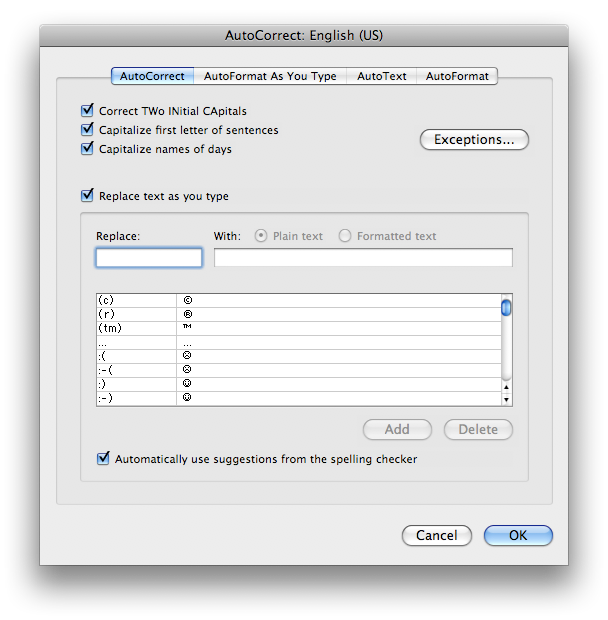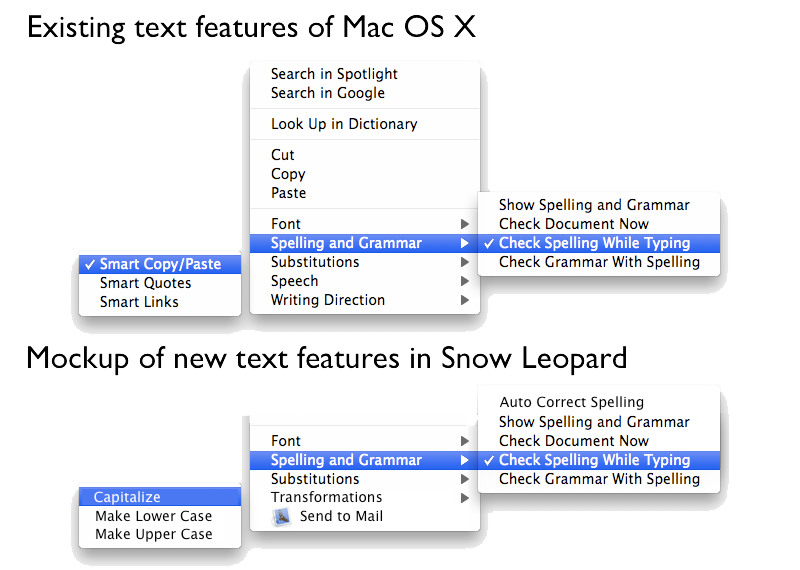Working with text in OS X 10.6 Snow Leopard
According to AppleInsider , the upcoming new version of OS X, called Snow Leopard, is expected to be available in the summer with new and advanced features for working with text. OS X users have the most powerful tool at their disposal - spell checking at the system level in any application (and not just in Office-compatible ones). Now this kit will be further improved.
Word users are familiar with the function of automatic text correction, when a word is incorrectly typed after pressing the space bar or the Enter key, the word is automatically corrected. For English-speaking users, this is often useful when typing teh (instead of the ) or Im (instead of I'm ). Those who use the Russian language may also encounter similar errors (for example, I often type and use instead of using) Therefore, this function can be very useful, because texts have to be typed not only in text editors, but also in blogs, forums, ICQ and other applications, when there is no time and desire to check typed text every time in a third-party spell checker. The help of the auto-corrector built into the operating system is very useful here.

The essence of this technology is that you can copy text in one application, send it to another application for processing, and then, if necessary, return the modified result back.
Services are present in current versions of OS X. But they are all hidden in a separate block in the application menu (the next item after the "bullseye"). Therefore, the user needs to make selections, then enter the menu, find the appropriate service in the general list. The vast majority of services will be unavailable, so you have to look for what you can use. No wonder that almost no one ever uses this feature. And for users of OS X, the presence of the "Services" section in the application menu often causes some bewilderment.
Now everything will be much easier. The list of services suitable for a specific selected area will pop up in the context menu. Since many of the services offered may be useful, this can significantly improve the work with text objects. All relevant services will be marked with the corresponding icon.
That is, if the service for sending this fragment in an email can be applied to the selected fragment, then the “Send To Mail” item with the corresponding icon will appear in the context menu:

In addition, as can be seen from the screenshot above, the “Transformations” section appears in the context menu , which has the function of converting all letters to uppercase or lowercase, or to make the first fragment a capital letter.
In fact, this is one of the types of those services that are only built-in at the system level: the selected text is placed in a temporary buffer, sent to the Transformations service, translates all the letters, for example, in capital letters and returns to the same place an already modified version .
A trifle, but nice. It is likely that for the final release of Snow Leopard will get a few of these useful services for working with text. For example, a text correction service typed in a different encoding (Latin instead of Cyrillic) will be very useful. Until now, this problem has been solved with the help of scripts or third-party applications, and meanwhile, it is much easier to put it on the shoulders of the system itself, since such an opportunity now appears. Correcting quotation marks, dashes, and other typographic characters for the selected text on the fly will also come in handy.
Now, a similar function will be available to any other applications using the Core Text framework. This means that if somewhere in the text (for example, on the forum, in ICQ or in a text editor) a number is printed that is recognized as a telephone number (for example, +7 (999) 123-45-67), then it will be is highlighted, and when you click on it, a context menu will appear, allowing you to add this number to any existing contact from the AddressBook or perform other functions.
It is likely that Snow Leopard will not be limited only to the above innovations, and we will see in the final version a rich toolbox that will allow users to greatly simplify the work with text.
It is regrettable that such functions are not yet available in other operating systems, since spell checking and auto-correction at the system level in a sense disciplines and significantly reduces the level of black-eyed and ashybak that the Internet has recently been overcrowded in excess of.
Automatic spell check
Word users are familiar with the function of automatic text correction, when a word is incorrectly typed after pressing the space bar or the Enter key, the word is automatically corrected. For English-speaking users, this is often useful when typing teh (instead of the ) or Im (instead of I'm ). Those who use the Russian language may also encounter similar errors (for example, I often type and use instead of using) Therefore, this function can be very useful, because texts have to be typed not only in text editors, but also in blogs, forums, ICQ and other applications, when there is no time and desire to check typed text every time in a third-party spell checker. The help of the auto-corrector built into the operating system is very useful here.
Lookups
Another feature that migrates to Snow Leopard from Word is substitutions. Using them you can get all sorts of emoticon, copyright signs and on the fly replace abbreviations with full names (for example, type “Jan” and get “January” or by typing “MOSX”, get something long like “Apple's Mac OS X operating system ”). Substitutions can be edited and configured in the “Replace text as you type” subsection:
Services
Snow Leopard will re-implement the Services feature, which was first introduced in NeXT.The essence of this technology is that you can copy text in one application, send it to another application for processing, and then, if necessary, return the modified result back.
Services are present in current versions of OS X. But they are all hidden in a separate block in the application menu (the next item after the "bullseye"). Therefore, the user needs to make selections, then enter the menu, find the appropriate service in the general list. The vast majority of services will be unavailable, so you have to look for what you can use. No wonder that almost no one ever uses this feature. And for users of OS X, the presence of the "Services" section in the application menu often causes some bewilderment.
Now everything will be much easier. The list of services suitable for a specific selected area will pop up in the context menu. Since many of the services offered may be useful, this can significantly improve the work with text objects. All relevant services will be marked with the corresponding icon.
That is, if the service for sending this fragment in an email can be applied to the selected fragment, then the “Send To Mail” item with the corresponding icon will appear in the context menu:

In addition, as can be seen from the screenshot above, the “Transformations” section appears in the context menu , which has the function of converting all letters to uppercase or lowercase, or to make the first fragment a capital letter.
In fact, this is one of the types of those services that are only built-in at the system level: the selected text is placed in a temporary buffer, sent to the Transformations service, translates all the letters, for example, in capital letters and returns to the same place an already modified version .
A trifle, but nice. It is likely that for the final release of Snow Leopard will get a few of these useful services for working with text. For example, a text correction service typed in a different encoding (Latin instead of Cyrillic) will be very useful. Until now, this problem has been solved with the help of scripts or third-party applications, and meanwhile, it is much easier to put it on the shoulders of the system itself, since such an opportunity now appears. Correcting quotation marks, dashes, and other typographic characters for the selected text on the fly will also come in handy.
Data Identifiers
Many people liked the function of data detection, which is present in Mail.app (and at the same time on the iPhone). The mail client automatically determines the email addresses, sites, phone numbers, addresses or calendar dates in letters. This allows you to quickly and easily add this data to your contacts or synchronize them with iCal or Address Book.Now, a similar function will be available to any other applications using the Core Text framework. This means that if somewhere in the text (for example, on the forum, in ICQ or in a text editor) a number is printed that is recognized as a telephone number (for example, +7 (999) 123-45-67), then it will be is highlighted, and when you click on it, a context menu will appear, allowing you to add this number to any existing contact from the AddressBook or perform other functions.
It is likely that Snow Leopard will not be limited only to the above innovations, and we will see in the final version a rich toolbox that will allow users to greatly simplify the work with text.
It is regrettable that such functions are not yet available in other operating systems, since spell checking and auto-correction at the system level in a sense disciplines and significantly reduces the level of black-eyed and ashybak that the Internet has recently been overcrowded in excess of.
